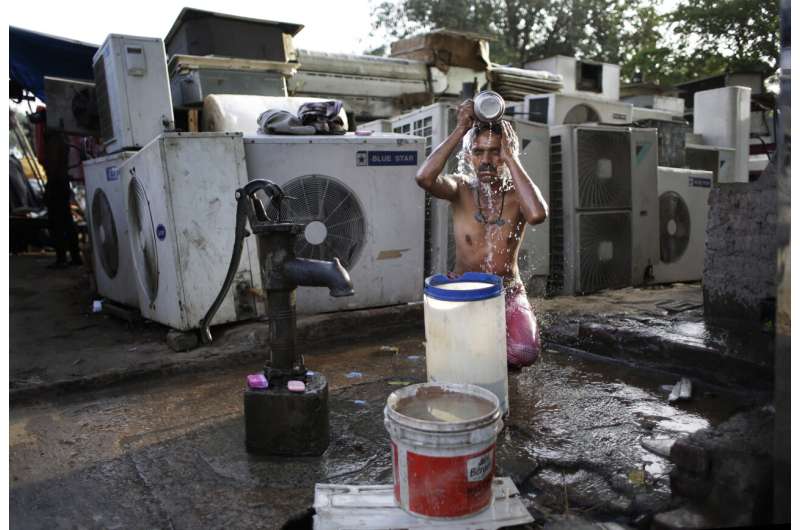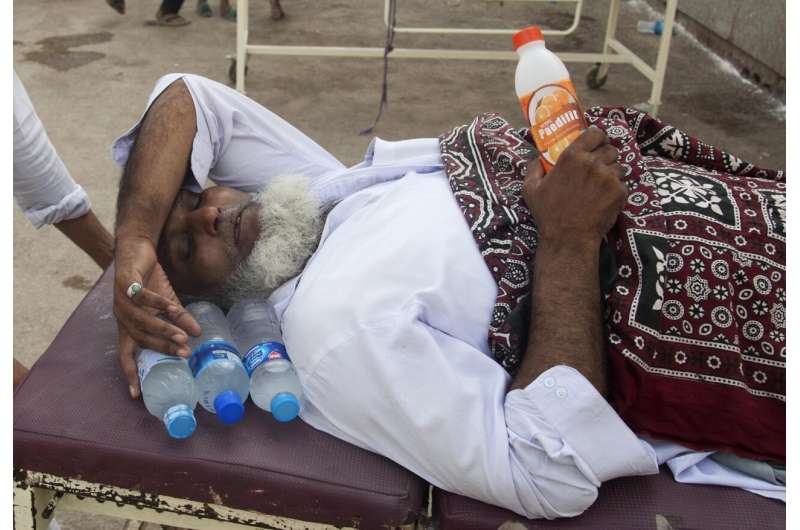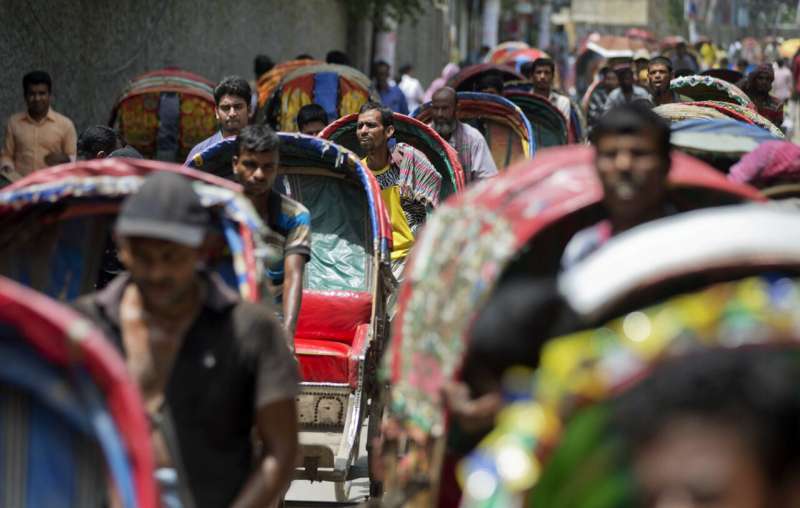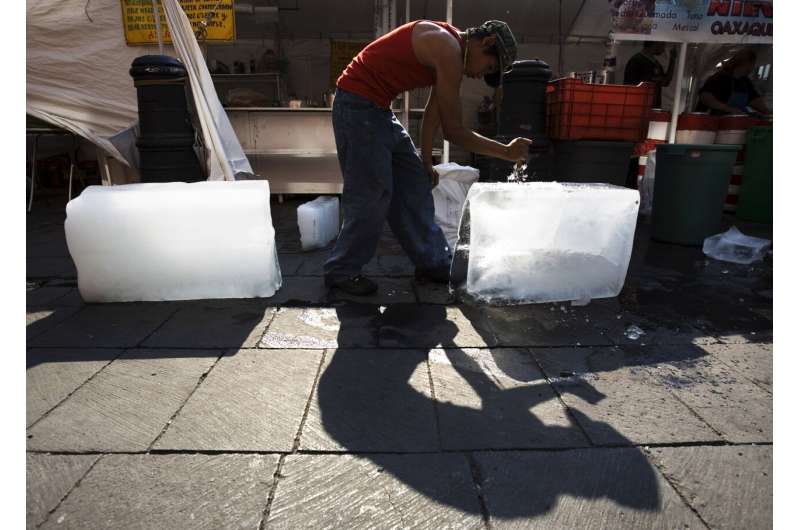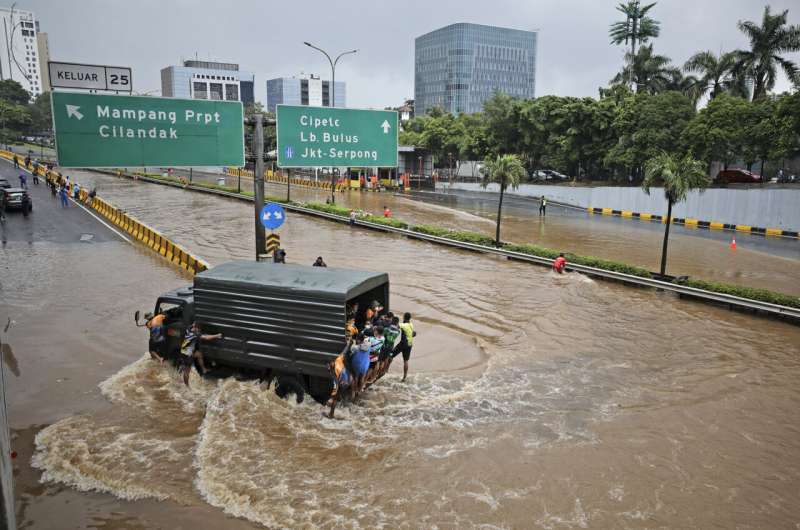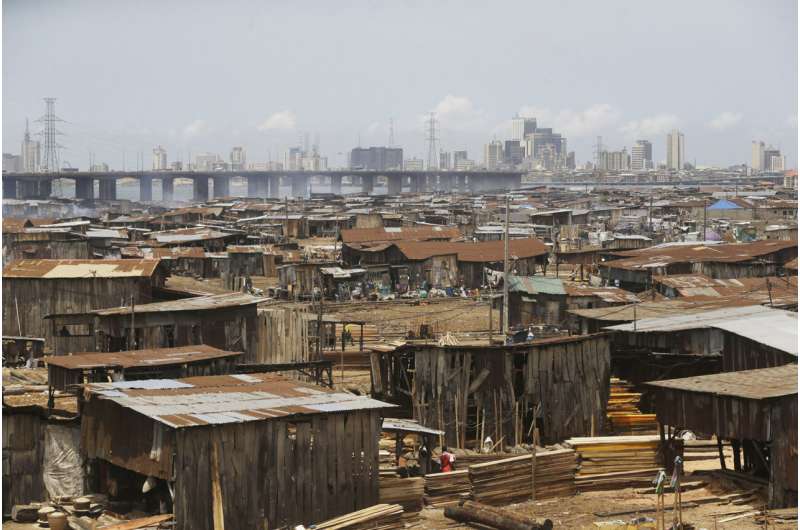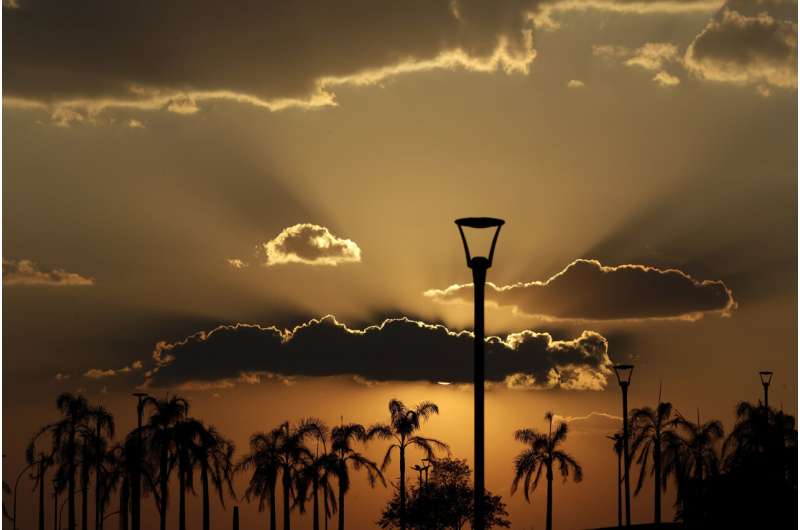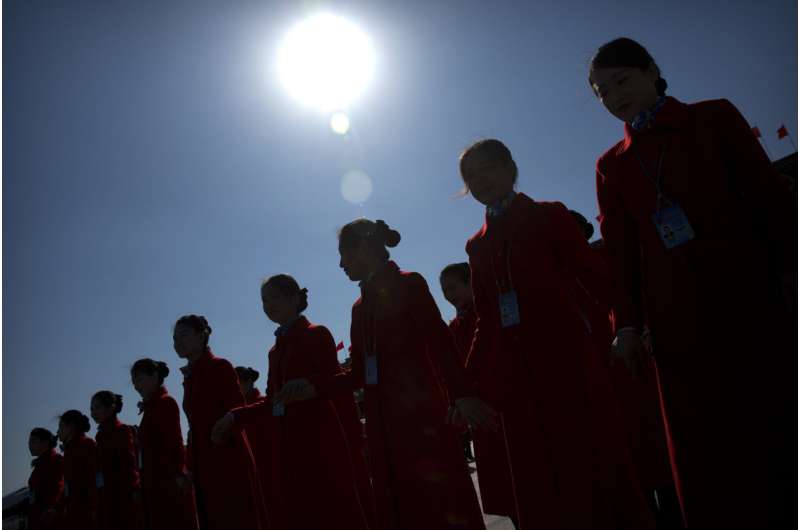A migrant daily wage worker bathes at a public well pump on a hot morning in New Delhi, India, Tuesday, May 17, 2016. Scorching summer temperatures, hovering well over 40 degrees Celcius, (104 Fahrenheit) are making life extremely tough for millions of poor across north India. Without access to air conditioning and sometimes even an electric fan, they struggle to cope with the heat in their inadequate homes. Credit: AP Photo/Altaf Qadri, File
World leaders have committed to limiting Earth's rising temperature to 1.5 degrees Celsius (2.7 degrees Fahrenheit) above pre-industrial times.
But what does that feel like?
It's difficult to convey, because you may not notice changes in average temperature. But, depending on where you live, you might notice when it's extremely hot.
To better understand the issue, Columbia University's climate school recently published a global dataset with estimates of both population and temperature. The Associated Press analyzed the data—spanning 1983 to 2016—and found that exposure to extreme heat has tripled and now affects about a quarter of the world's population.
HOW HEAT IS MEASURED
As the global average temperature rises, so do the hottest daily temperatures. And, in some places, the hottest days can be dangerous to human health, causing heat stress.
Heat stress can create a host of health problems, including rashes, cramps and heat stroke. Hot air is not the only risk factor for it. Other factors include humidity, wind speed and the amount of shade.
You may be familiar with the heat index, which takes into consideration temperature and humidity to suggest what it feels like in the shade on a hot day. But even the heat index doesn't tell you what it's like to be working in the full sun on an extremely hot windless day.
An elderly man suffering from heatstroke waits for a medical help at a local hospital in Karachi, Pakistan, Friday, June 26, 2015, during a heat wave that struck southern Pakistan. Credit: AP Photo/Shakil Adil, File
Increasingly, climate scientists and meteorologists are advocating for the use of a different metric for understanding extreme heat. It's called wet-bulb globe temperature and it takes into account temperature, humidity, wind speed, sun angle and cloud cover.
The new dataset uses estimates of both population and wet-bulb globe temperature to better understand how many people are affected by dangerously hot temperatures and where they live.
When the wet-bulb globe temperature exceeds 30 degrees Celsius (86 degrees Fahrenheit), people are advised to start taking rests if they're working outdoors.
HEAT EXPOSURE IS RISING
To match heat measures with population estimates, the researchers averaged temperature data over 13,115 urban centers identified in a dataset produced by the European Union.
Out of those urban centers around the world, nearly half experienced an increasing trend in heat exposure.
Rickshaw pullers wait in a line, awaiting passengers in Dhaka, Bangladesh, Wednesday, July 11, 2018. In Dhaka, the population more than tripled from about 7.7 million in 1983 to 24 million in 2016. While the city grew by more than 16 million people, the number of extreme heat days also increased by 1.5 days a year, until Dhaka experienced about 50 more dangerously hot days a year than it did in 1983. Credit: AP Photo/A.M. Ahad, File
In 2016, just under 1.7 billion people lived in those areas, with the majority in Asia and sub-Saharan Africa.
The most affected region, by far, was southern Asia, where India alone accounted for 37% of the population living in areas with an increasing extreme heat trend.
With population growth from 1983 to 2016 for each city and estimates for the year-to-year increase in annual counts of dangerously hot days, the AP was able to identify the cities in the world where exposure to extreme heat is increasing most.
NOTABLE HEAT EXPOSURE INCREASES
In Dhaka, Bangladesh, the population more than tripled from about 7.7 million in 1983 to 24 million in 2016. While the city grew by more than 16 million people, the number of extreme heat days also increased by 1.5 days a year, until Dhaka experienced about 50 more dangerously hot days a year than it did in 1983.
A fan sprays water mist as customers sit outside a cafe in downtown Rome on Friday, July 31, 2020, during a heat wave with temperatures over 34 Celsius (104 Fahrenheit). Credit: AP Photo/Riccardo De Luca, File
This large population growth, along with the warming trend for the area, reveals that Dhaka had the biggest increase in heat exposure in the world.
Population growth and increasing temperature both contribute to exposure trends. In some cases, these have an equal effect. That was the case in Kolkata, India, where the population grew by 6 million people and the number of hot days grew by 1.76 each year. Both of these increases contributed to a steep exposure trend.
Meanwhile, New Delhi added nearly 14 million people. While the city added 1.12 additional hot days each year, the population increase is what made Delhi's exposure trend the steepest in India.
INDONESIA'S CAPITAL
This dataset focuses on the past, but could help world leaders make more informed decisions in the future. Indonesia is planning to move the country's capital from Jakarta—a city that is sinking below sea level—to Kalimantan. The development site is in an area of jungle between two cities, Samarinda and Balikpapan. Both cities have increasing heat exposure trends.
A farmworker, who declined to give his name, wipes sweat from his neck while working, Thursday, July 1, 2021, in St. Paul, Ore., as a heat wave bakes the Pacific Northwest in record-high temperatures. Credit: AP Photo/Nathan Howard, File
People in Balikpapan, located at the mouth of the Bakpapan Bay, could expect 10 more days of extreme heat in 2016 compared with 1983.
Samarinda, situated on the humid Mahakam River delta, could expect 19 more days. Jakarta, although sinking, did not register a significant increasing exposure trend in the dataset.
AFRICA'S GROWING CITIES
Many cities that already experience extreme heat are growing rapidly.
Douala, Cameroon, grew from roughly 760,000 people in 1983 to nearly 3 million in 2016. United Nations population projections suggest that count will double by 2035. Douala's citizens endured 76 days of extreme heat in 2016.
Douala is representative of sub-Saharan Africa as a whole. According to the 2019 U.N. World Population Prospects, most of the world's population growth will come from this region in the coming years, and it's growing rapidly at a time when warming trends are increasing in cities across the area. Whether world leaders are able to limit the rise in the global average temperature, people in this part of the world will likely feel the difference in the resulting heat exposure most.
-
Katherine Morgan drinks water in front of a box fan while trying to stay cool in her downtown apartment without air conditioning on Thursday, Aug. 12, 2021, in Portland, Ore. People have headed to cooling centers as the Pacific Northwest began sweltering under another major, multi-day heat wave. Credit: AP Photo/Nathan Howard, File
-
A street vendor breaks blocks of ice to be used to cool beverages for sale in downtown Mexico City, Wednesday, April 8, 2008, as the country experiences unusually hot weather for this time of the year, with highs of 81 degrees Fahrenheit. Credit: AP Photo/Alexandre Meneghini, File
-
People wash clothes as others rest on a hot summer day on the banks of the Hooghly River in Kolkata, India, Friday, June 14, 2019, as severe heat wave conditions sweep through north and western parts of India. Credit: AP Photo/Bikas Das, File
-
A military truck drives through the water on a flooded toll road following heavy rains in Jakarta, Indonesia, Saturday, Feb. 20, 2021. Heavy downpours combined with poor city sewage planning often causes heavy flooding in parts of greater Jakarta. Indonesia is planning to move the country's capital from Jakarta—a city that is sinking below sea level—to Kalimantan. Credit: AP Photo/Dita Alangkara, File
-
A woman holds a portable fan in Tokyo, Monday, July 23, 2018, as searing hot temperatures are forecast for wide swaths of Japan and South Korea in a long-running heat wave. Credit: AP Photo/Koji Sasahara, File
-
People in a slum work in a saw mill with downtown in the distance in Lagos, Nigeria, Tuesday May 12, 2020. Dim Coumou, a climate professor at Vrije Universiteit Amsterdam, said the combination of growth in African cities and climate change presents a serious risk. "As the population increases in these megacities, you have more buildings, more concrete and an increased heat-island effect, making the heat waves worse," Coumou says. "I think it's a dangerous combination." Credit: AP Photo/Sunday Alamba, File
-
Palm trees in City Park are silhouetted at dusk after temperatures peaked at 40 degrees Celsius (100.4 degrees Fahrenheit) in Brasilia, Brazil, Tuesday, Oct. 6, 2020. Credit: AP Photo/Eraldo Peres, File
-
Hospitality staff are silhouetted by the sun as they pose for a group photo during a plenary session of the Chinese People's Political Consultative Conference (CPPCC) at the Great Hall of the People in Beijing, Thursday, March 9, 2017. Credit: AP Photo/Mark Schiefelbein, File
Dim Coumou, a climate professor at Vrije Universiteit Amsterdam, said the combination of growth in African cities and climate change presents a serious risk.
"As the population increases in these megacities, you have more buildings, more concrete and an increased heat-island effect, making the heat waves worse," Coumou said. "I think it's a dangerous combination."
© 2021 The Associated Press. All rights reserved. This material may not be published, broadcast, rewritten or redistributed without permission.
